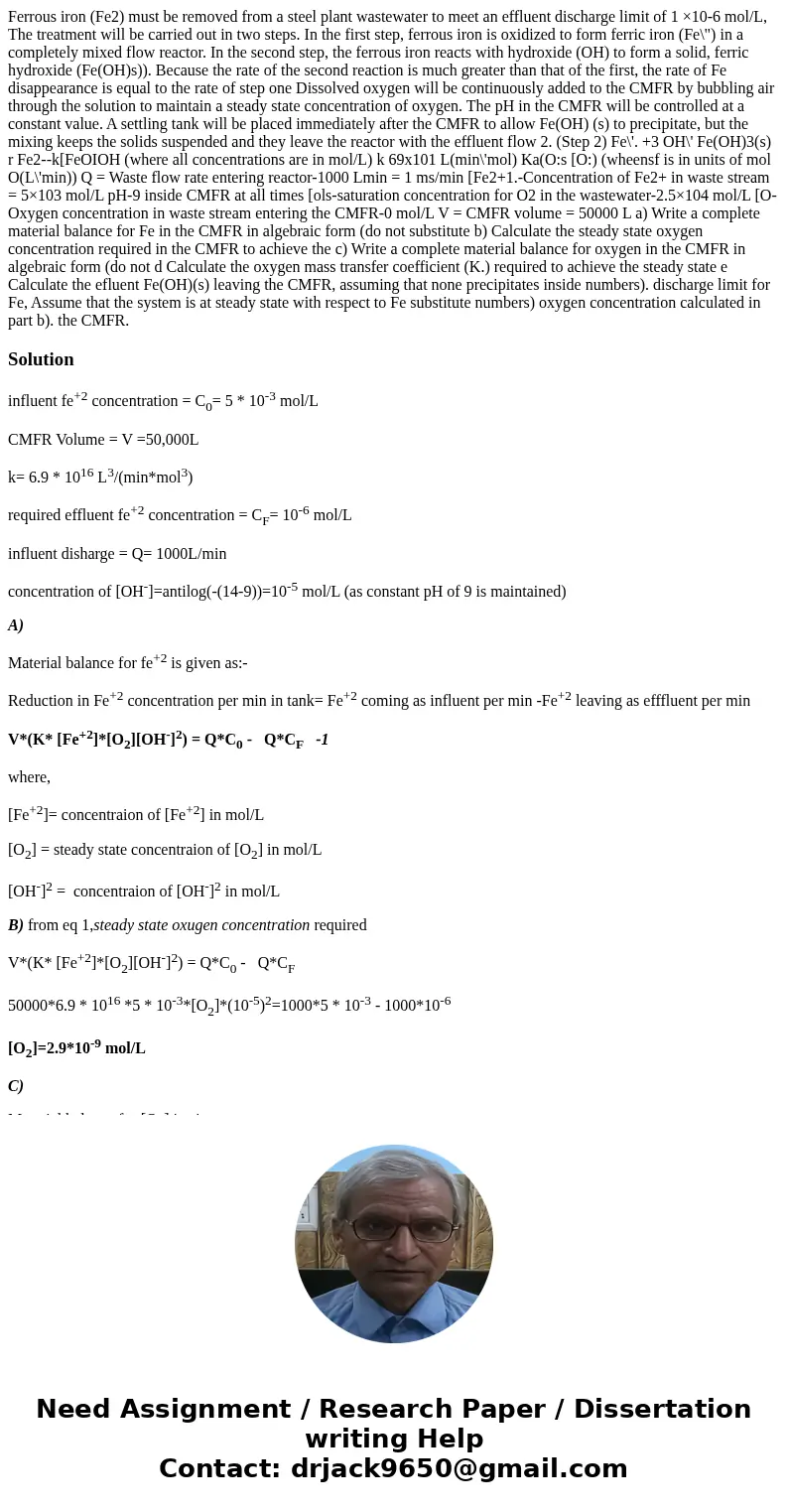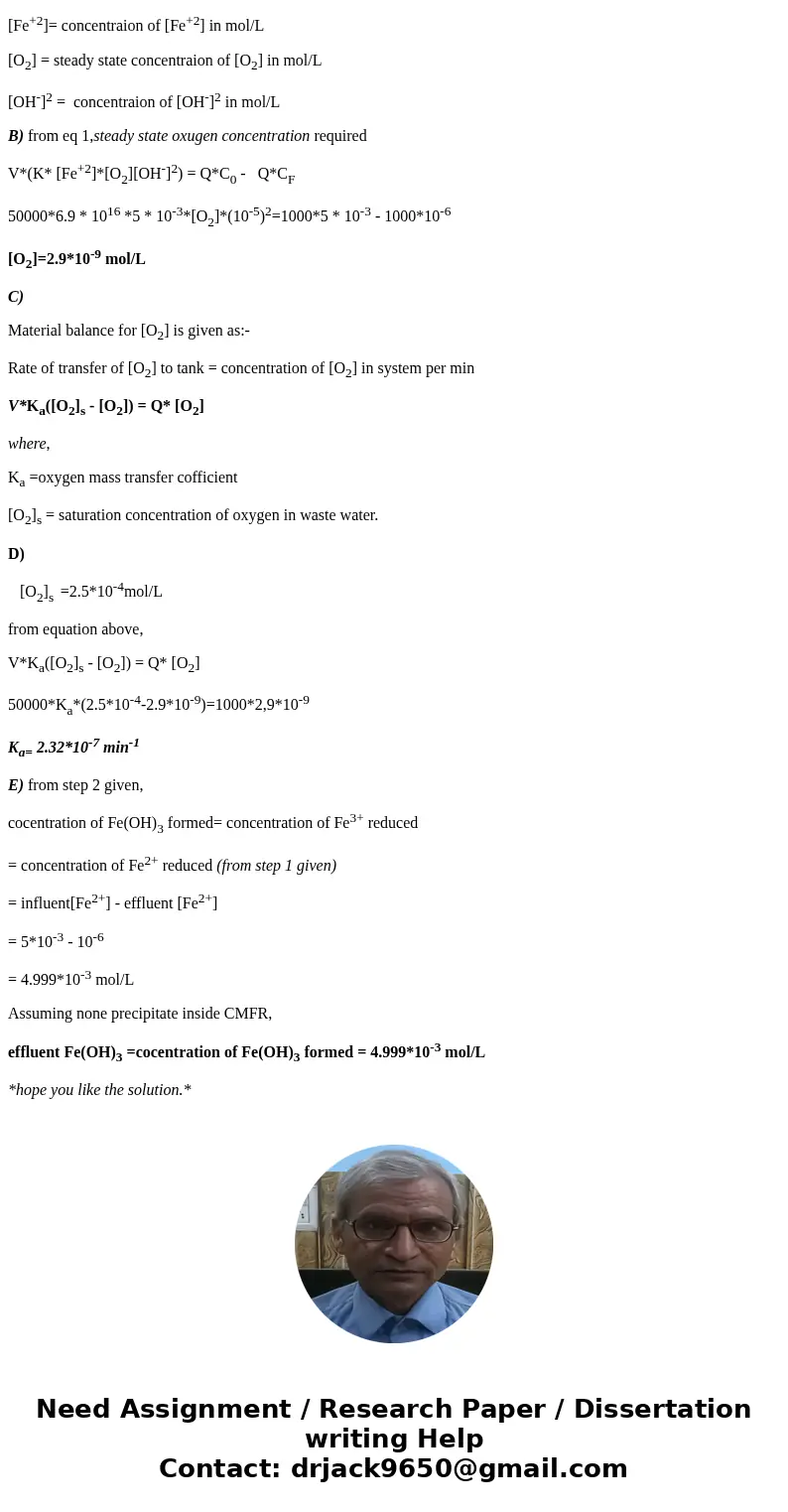Ferrous iron (Fe2) must be removed from a steel plant wastewater to meet an effluent discharge limit of 1 ×10-6 mol/L, The treatment will be carried out in two steps. In the first step, ferrous iron is oxidized to form ferric iron (Fe\") in a completely mixed flow reactor. In the second step, the ferrous iron reacts with hydroxide (OH) to form a solid, ferric hydroxide (Fe(OH)s)). Because the rate of the second reaction is much greater than that of the first, the rate of Fe disappearance is equal to the rate of step one Dissolved oxygen will be continuously added to the CMFR by bubbling air through the solution to maintain a steady state concentration of oxygen. The pH in the CMFR will be controlled at a constant value. A settling tank will be placed immediately after the CMFR to allow Fe(OH) (s) to precipitate, but the mixing keeps the solids suspended and they leave the reactor with the effluent flow 2. (Step 2) Fe\'. +3 OH\' Fe(OH)3(s) r Fe2--k[FeOIOH (where all concentrations are in mol/L) k 69x101 L(min\'mol) Ka(O:s [O:) (wheensf is in units of mol O(L\'min)) Q = Waste flow rate entering reactor-1000 Lmin = 1 ms/min [Fe2+1.-Concentration of Fe2+ in waste stream = 5×103 mol/L pH-9 inside CMFR at all times [ols-saturation concentration for O2 in the wastewater-2.5×104 mol/L [O-Oxygen concentration in waste stream entering the CMFR-0 mol/L V = CMFR volume = 50000 L a) Write a complete material balance for Fe in the CMFR in algebraic form (do not substitute b) Calculate the steady state oxygen concentration required in the CMFR to achieve the c) Write a complete material balance for oxygen in the CMFR in algebraic form (do not d Calculate the oxygen mass transfer coefficient (K.) required to achieve the steady state e Calculate the efluent Fe(OH)(s) leaving the CMFR, assuming that none precipitates inside numbers). discharge limit for Fe, Assume that the system is at steady state with respect to Fe substitute numbers) oxygen concentration calculated in part b). the CMFR.
influent fe+2 concentration = C0= 5 * 10-3 mol/L
CMFR Volume = V =50,000L
k= 6.9 * 1016 L3/(min*mol3)
required effluent fe+2 concentration = CF= 10-6 mol/L
influent disharge = Q= 1000L/min
concentration of [OH-]=antilog(-(14-9))=10-5 mol/L (as constant pH of 9 is maintained)
A)
Material balance for fe+2 is given as:-
Reduction in Fe+2 concentration per min in tank= Fe+2 coming as influent per min -Fe+2 leaving as efffluent per min
V*(K* [Fe+2]*[O2][OH-]2) = Q*C0 - Q*CF -1
where,
[Fe+2]= concentraion of [Fe+2] in mol/L
[O2] = steady state concentraion of [O2] in mol/L
[OH-]2 = concentraion of [OH-]2 in mol/L
B) from eq 1,steady state oxugen concentration required
V*(K* [Fe+2]*[O2][OH-]2) = Q*C0 - Q*CF
50000*6.9 * 1016 *5 * 10-3*[O2]*(10-5)2=1000*5 * 10-3 - 1000*10-6
[O2]=2.9*10-9 mol/L
C)
Material balance for [O2] is given as:-
Rate of transfer of [O2] to tank = concentration of [O2] in system per min
V*Ka([O2]s - [O2]) = Q* [O2]
where,
Ka =oxygen mass transfer cofficient
[O2]s = saturation concentration of oxygen in waste water.
D)
[O2]s =2.5*10-4mol/L
from equation above,
V*Ka([O2]s - [O2]) = Q* [O2]
50000*Ka*(2.5*10-4-2.9*10-9)=1000*2,9*10-9
Ka= 2.32*10-7 min-1
E) from step 2 given,
cocentration of Fe(OH)3 formed= concentration of Fe3+ reduced
= concentration of Fe2+ reduced (from step 1 given)
= influent[Fe2+] - effluent [Fe2+]
= 5*10-3 - 10-6
= 4.999*10-3 mol/L
Assuming none precipitate inside CMFR,
effluent Fe(OH)3 =cocentration of Fe(OH)3 formed = 4.999*10-3 mol/L
*hope you like the solution.*


 Homework Sourse
Homework Sourse